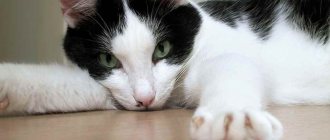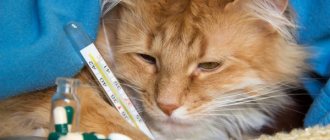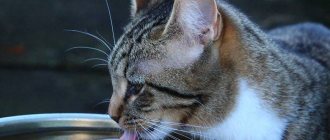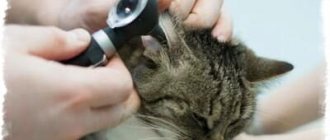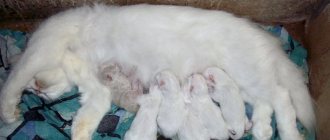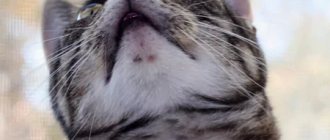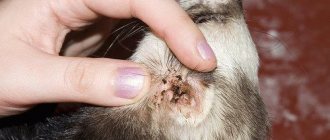What will you learn from the article?
- Causes of runny nose (rhinitis) in cats
- Symptoms of feline rhinitis
- How to treat a runny nose in a cat Folk remedies
A runny nose in a cat is not an independent disease, it is a sign of many diseases, which can include both mild ailments and serious and dangerous pathologies. The sense of smell is the most important sense for cats, so as soon as you notice your pet has a runny nose, congestion, difficulty breathing or discharge from the nostrils, contact your veterinarian immediately.
Cat anatomy means they have very narrow nasal passages, so even a small amount of swelling can cause complete nasal congestion. A stuffy nose will not be able to perform its functions: warm and clean the inhaled air. Less oxygen will reach the brain, and the cat may become hypothermic.
Causes of colds in cats
Cat colds are a series of infectious diseases of the upper respiratory tract. It responds well to treatment, but lack of timely treatment can lead to serious complications. The immune system of cats is quite well developed and often copes with viruses on its own, so colds in cats are not so common. Among the main causes of infection is decreased immunity and contact with virus carriers.
An unbalanced diet, poor maintenance, low ambient temperature, drafts and stress can trigger the development of a cold in a cat.
Causes
It is impossible to make an accurate diagnosis and find out how to treat a runny nose in a cat without appropriate education and experience. However, if you look closely at the condition of the animal, you can determine the type of disease.
- Colds due to hypothermia, for example after swimming. Green discharge from both nostrils.
- Infection (viral, bacterial). You can catch the disease from another pet. The snot is thick and cloudy. Cats often have watery eyes.
- Infection (fungal). The disease is often chronic, and the cat has a runny nose mixed with pus and an unpleasant odor.
- Trauma, including the presence of foreign bodies in the nasopharynx. The mucus is mixed with blood, but flows out of only one nostril.
- Pathology of teeth and gums. Purulent rhinitis is observed. It can be one-sided or two-sided, this is due to where the abscesses have formed.
This is an incomplete list of reasons. The discharge may be caused by allergies, high blood pressure, or breed characteristics such as a short muzzle.
Owners do not always begin treatment for runny nose in cats immediately. If it is a common cold and there is little discharge, then you can postpone going to the veterinarian. However, if after a week the patient does not feel better, and the mucus interferes with breathing, it is worth taking action.
How does a cold manifest in cats?
Colds in cats. The symptoms of viral diseases in cats are similar, however, successful treatment is only possible with the correct diagnosis. Therefore, when your pet shows signs of a cold, you should urgently consult a specialist. Tests may be needed to determine the virus that causes the illness. Colds are more common in kittens due to their rather weak immunity. The main symptoms include:
- increased body temperature (nose becomes dry and hot)
- lack of appetite
- runny nose and sneezing
- heavy breathing, cough
- tearfulness
- apathy, etc.
Why is rhinitis dangerous for cats?
A runny nose in cats is a common disease, but it is not at all as harmless as some owners believe. A cat's nose is an unusually sensitive instrument, a kind of odor indicator. For this reason, animals can easily figure out where the desired object is, even when it is located at a great distance. Cats' nasal passages are narrow, and swelling caused by inflammation can completely block the nose. A runny nose in a cat is an unpredictable disease. Blocked nasal passages do not cope with their functions of cleaning and warming the air. The animal can only breathe through the mouth; cold air easily penetrates into the lungs. This can provoke hypothermia and an inflammatory process. A cat experiencing oxygen starvation becomes lethargic and lifeless, which leads to exhaustion and dehydration. If you do not treat rhinitis in a cat, it will become chronic, and the life of your pet will turn into sheer agony.
Types of colds
Most often, the causes of colds in cats are acute viral and bacterial infections such as herpes virus, calicivirus, bordetellosis, chlamydia, mycoplasmosis.
Herpes. Viral infection of cats.
The virus is practically unstable and persists for no more than 18 hours in the external environment. Transmission of the virus through contact and household contact. Animals become infected through close contact with each other through household objects, carriers, and cages. After infection, an acute period develops within 2-6 days. Symptoms appear: sneezing, copious mucopurulent discharge from the nose and eyes, breathing through the mouth, depression, fever, redness of the conjunctiva, dermatitis in the nose and eyes, ulcers in the mouth. As a complication, young and weakened cats may develop pneumonia.
On the 20th day, the symptoms subside and a latent period begins, when the cat is clinically healthy, does not release the virus into the external environment, but becomes a lifelong virus carrier. Following immunosuppressive medications, steroid therapy, or stress, the virus may reactivate and the cat may begin to exhibit mild clinical symptoms. Episodes of viral shedding occur in 50% of cats during relapse of the disease.
Feline calicivirus
Stable in the external environment for up to 10 days. Transmission of infection through contact and household contact. The acute period lasts 2-14 days, during which there is damage to the oral mucosa (ulcers and erosions), refusal to feed, and active salivation.
After 20 days, the cat becomes a chronic virus carrier; it will be clinically healthy, but will constantly shed the virus for several years. Since calicivirus has many strains of the virus, a cat that has had one can become infected and become ill with another type of calicivirus.
Chlamydia in cats
The pathogen is unstable in the environment and is transmitted by contact.
The incubation period is from 3 to 14 days. Clinical symptoms: bilateral conjunctivitis, in the acute form, mucopurulent discharge from the nose, sneezing. Isolation of the pathogen after clinical recovery takes several months.
Kittens aged 2 to 12 months are at risk; in cats over 5 years of age, infection is unlikely.
Bordetellosis
The virus is stable in the external environment for up to 10 days and can reproduce in natural bodies of water. Airborne transmission of infection. Accompanied by mucopurulent nasal discharge, sneezing, conjunctivitis. Complications may develop in the form of pneumonia, fever, shortness of breath, and hyporexia. After recovery, the cat continues to excrete the pathogen for several months.
Young kittens are at risk; they also have a high risk of rapid progression of the disease.
Mycoplasmosis
A secondary pathogen in the development of diseases of the upper respiratory tract, the disease itself cannot cause rhinitis. A lot of bacteria normally live in the nose; they can cause rhinitis, but they cannot be primary. Bacteria develop against the background of mucosal injury for any reason: viral damage, foreign body, tumor growth, etc. When an integral layer of mucous membrane is damaged, bacteria begin to actively multiply and cause purulent inflammation. Such rhinitis is secondary and diagnosis of the root cause is necessary.
Treatment at home
There is no universal way to cure a runny nose in a cat at home. It all depends on the disease. For example, if you have a cold, it is recommended to give your cat food with a high content of vitamins A and C.
If a cat has a runny nose and is sneezing, it is not the symptoms that should be treated, but the cause of the disease. However, this is usually not possible at home, so you can simply reduce the overall inflammation.
What to wash with?
The easiest way to cure a runny nose in a cat is to drip medicine into the nostrils. Although this will not help if you have a serious illness, it will help relieve symptoms. You can bury:
- aloe juice 1 drop once a day for a week;
- boiled beet juice 1 drop 2 times a day for 5 days;
- saline solution - 2-3 drops 2-3 times a day for a week;
- Naphthyzin (for children) - 1 drop 1 time per day for 4 days.
The listed remedies are folk methods for treating a runny nose in a cat at home. They may cause allergies or have no effect. If the animal is suffering from a bacterial infection, these methods will not help, since antibiotics are required, which are taken orally.
If the disease is associated with injury and flows from only one nostril, it is better to use ointment to speed up regeneration. And wipe only where the wound is located.
How to rinse and instill nose
It’s clear what medications to use and what to do if your cat has a runny nose. However, the next question is how to instill or rinse the nose, because the kitten is unlikely to calmly endure this procedure.
As with any unpleasant procedures, the cat must first be immobilized: wrapped in a towel, placed in a sock or pant leg. The main thing is to press the paws to the body so that it cannot escape or scratch the owner.
Remedies for the treatment of runny nose in cats at home should be instilled using a pipette. The liquid should be at room temperature. It is imperative to adhere to the dosage so as not to dry out the mucous membrane.
In addition to instillation, other methods can be used. For example, a good way to cure a runny nose in a cat at home is heating it with warm salt or an ultraviolet lamp. But, if traditional methods do not help, and the snot does not go away for more than a week, you should contact the clinic.
The reasons why a cat sneezes are as follows:
- colds - as a rule, a runny nose in an animal causes sneezing;
- viral infections in the nasopharynx (adenovirus, herpes cause rhinitis);
- various formations (growths, polyps) impede the movement of air in the nasal area;
- allergic manifestations to any irritants;
- asthma, which causes narrowing of the lumen and worsening of air passage, usually also leads to the cat sneezing and at the same time there is a feeling that the animal is having difficulty catching its breath;
- worms that enter the body through insect bites cause blockage in the blood vessels and lungs, thereby impairing breathing;
- dental diseases and gum inflammation;
- malignant tumors in the nasal cavity block the nasal passages, preventing the free movement of air (an X-ray and an endoscopic examination must be done)
One of the main reasons is cat allergies. The following allergens cause cat sneezing :
- perfume or eau de toilette, spray deodorants of the owners;
- mold fungi on the walls of rooms, bathrooms;
- pollen of flowering plants;
- various insect repellent sprays;
- cigarette smoke, which has a bad effect on animals in general;
- various detergents and cleaning products based on chemicals.
All this penetrates into the nasal passages of the cat (cats), severely irritates the mucous membrane and causes frequent sneezing.
What to do if a kitten sneezes
If you just recently got a kitten and it suddenly starts sneezing, your concern is not difficult to understand. But what to do? There is no definite answer here, and regardless of the reasons, the best solution is to contact a veterinary clinic. Only a professional can determine why a kitten sneezed, and he can also choose safe treatment.
A very common cause of sneezing in a kitten is viral or fungal infections, as well as a foreign object getting into the nose.
In any case, you should not try to fix the problem and cure your pet on your own. Only a veterinarian can clear the airways or prescribe the right medicine; by trying to help you will only harm the animal.
POLAR BEAR
The veterinary clinic in Nizhny Novgorod "White Bear" provides all types of services for cats and dogs.
Conducts any examinations and tests in its own veterinary laboratory; the clinic operates a veterinary ambulance for animals and a 24-hour veterinarian is on call at home. Agreement on the processing of personal data
Public offer
SITE MENU
- About the clinic
- Price list for veterinary clinic services
- Treatment
- Services
- Price list for veterinary clinic services
- Vetapteka
- Contacts
- Site Map
CONTACTS
- Nizhny Novgorod st. Vyatskaya 7
- 8 (831) 437-25-27
- [email protected]

